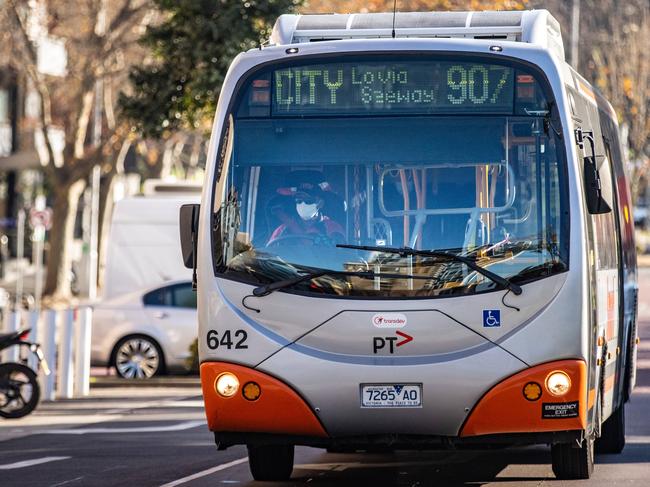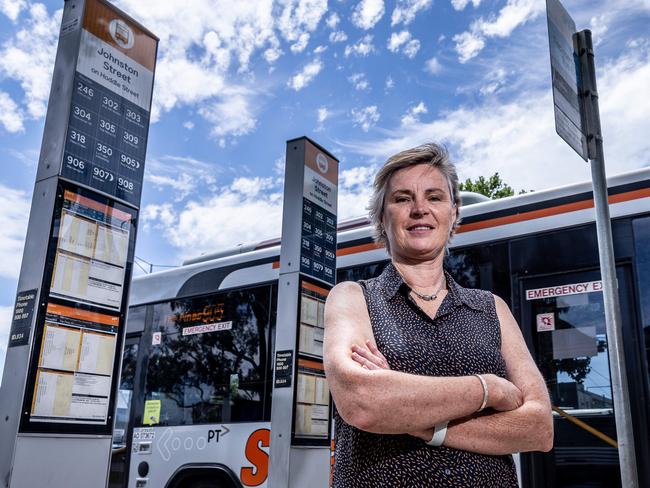More buses, more often need in major Melbourne network shake up: report
One-in-three Melburnians has never used the city’s bus network despite most people living within 400 metres of a bus stop. Infrastructure Victoria has a plan to change that.
Victoria
Don't miss out on the headlines from Victoria. Followed categories will be added to My News.
A major investment in Melbourne’s bus network to provide more services more often is needed to meet the city’s transport needs, especially in booming growth areas, a new report has found.
Getting more buses on Melbourne’s roads was simply a “no-brainer’’, Infrastructure Victoria head Jonathan Spear said.
Buses were affordable, flexible and a fraction of the cost of other major transport infrastructure, a report found.
The report, Fast, Frequent, Fair: How Buses Can Better Connect Melbourne, makes 10 recommendations to the state government.
The report recommends the creation a network of rapid transit bus corridors across Melbourne over five years and would follow Sydney, Brisbane and Adelaide which had already embraced bus rapid transit.
“Look across the border. Look in NSW. Look at Queensland. This is not rocket surgery. This is genuine low-hanging fruit. This is a no-brainer,’’ Mr Spear said.

“And the people it benefits the most are the people who are less well off and need it now.’’
Melburnians needed to change their mindset about buses, the agency’s deputy chief executive Allison Stewart said.
“More than a third (34 per cent) of Melburnians have never caught the bus, even though eight out of 10 (82 per cent) of us live within 400m of a bus stop.’’
“We’ve identified in this report a few priority reforms – very sensible things like straightening out bus routes, having buses come more frequently, operating them more hours and ensuring that growth areas have the public transport that they need when they need it,’’ Dr Stewart told the Herald Sun.
“We need a great bus network. We need buses, we need them to be faster. More frequent. Better connected. And we can do it.’’
Cheaper fares would also encourage more use, she said.
“Research shows every $1 reduction in bus fares leads to up to 20 per cent more boardings.”
Improved bus services would provide transport certainty for people moving to new housing estates on the city fringes. The report found that about 60 per cent of residents in those areas don’t have access to a bus service that runs more than every 20 minutes.
It also said that major bus network changes could create an extra 164,000 bus boardings which would effectively take up to 63,000 vehicles off the city’s roads every day – about the same number of vehicles that travel daily through the Domain Tunnel.
“I’ve never seen an inspector once”: Nurse rates bus commute

Nurse Carolyn Mueller knows that taking a comfortable bus ride is preferable to sitting in her car in peak-hour traffic. Andit’s quicker and cheaper.
Ms Mueller’s trip from Warrandyte to Collingwood by bus takes 45 minutes and avoids the stress of traffic congestion.
Buses use the emergency lanes at the end of the freeway to enter Hoddle St, Ms Mueller said.
“We get to go pass all the cars lined up.’’
“I love it. It’s great. And I don’t have to worry about parking in Collingwood because that’s just terrible.
The daily return cost of $9.20, which works out cheaper than paying for petrol and parking, but Ms Mueller said it should be cheaper to encourage more use.
“It doesn’t sound a lot but I think that’s pretty pricey but if we want to get more people on public transport we need to drop the price.
“Another way is to actually enforce people touching on and off. I see so many people who don’t, probably about 40 to 50 per cent.
“So if you drop the price to encourage more use and also enforce touching on they could get a lot of revenue and improve the service.
“I’ve been on the bus for 14 months now and I’ve never seen an inspector once.’’





